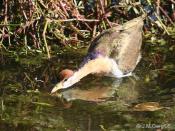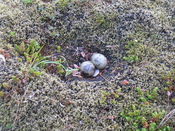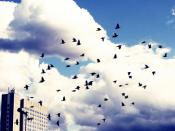Birds :Their habits and behaviour.
Distinctive characters of birds :
1. Birds are feather clad, air breathing, warm blooded, oviparous and bipedal flying vertebrates.
2. They have a streamlined spindle shaped body that helps them to fly in air.
3. The bird's body is divisible into 4 distinct parts - head, tail, neck and trunk.
4. The entire body of birds is invested with a close covering of feathers, constituting the plumage.
5. The birds have two pairs of limbs: -the fore limbs which are modified into wings and the hind limbs or legs
6. The skin of birds are dry.
7. They have light bodies.(As their bones are hollow and have air cavities.)
8. Their hearts have 4 chambers.
9. They are homothermous animals.
10. They have a small tongue but no teeth. The functions of the teeth are done by an organ called gizzard in their
Stomach.
11. The lungs of birds are spongy compact and have air cavities in them.
12. They excrete semisolid waste in form of uric acid.
13. Their syrinx(voice box ) is located at the base of their windpipe.
14. Though their sense organs of smell is poorly developed their eyesight is very good.
15. They have separate sexes.
16. Male birds have a pair of testes but often lack the penis. The female birds have a single functional ovary and oviduct.
17. Fertilization is internal.
18. The eggs of birds are large with much yolk and hard shell.
19. Parental care of the young newly hatched birds is well marked in birds.
Types of birds :-
1. Flightless birds :-These birds are usually large with long powerful legs. E.g. Ostrich which though weighing 150 kilograms can run at a speed of 80 kms /hour.
2. Flying birds
Adaptations of birds :-
A) Structural adaptation of birds
Beaks : - The beak is an important part of the birds. It lacks teeth and serves both as mouth and hands. Therefore the type of beak which is found in any bird largely depends on its eating habits. Eg. crow has a biting and cutting type of beak since it is omnivorous whereas the tongue of a sparrow is specially designed for eating fruits.
Wings : - The wings of birds have strong flight muscles which help in combining both strength and lightness. Each type of bird has a different type of wing to suit its lifestyle. For example :the crimson breasted barbet has short and broad wings because it does not need to fly much and spends most of the time in the orchards and gardens eating fruits etc. Whereas birds like swallows and swifts who have to spend a great deal of their time flying and eating on selective insects have long, slender and slightly curved wings which are ideally suited for their fast flying habits.
Tail :- The tail helps in balancing and steering the bird. It also acts as a break. It is an integral part of a bird and largely depends on the lifestyle of the bird. For example :the swallow has a deep fork tail to add to its agility while trying to catch an insect whereas the white breasted kingfisher has a short, stumpy tail as it helps the bird in getting a straight scoop towards a fish, tadpole etc. on which the birds feed.
Feet :- The feet of the birds are also modified as according to the habitat in which the birds live and the manner of their locomotion. For example : Predatory birds such as kites and hawks have strongly clawed feet for striking and grasping their prey. Sparrows and bulbuls on the other hand have perching feet which they securely fasten to a branch or a perch.
Colouration :-It is also known as camouflage. It helps the birds to merge with their surroundings in order to protect themselves. For example : the brown and black colours of flinchlarks help them to merge well with the surrounding soil, rocks and grasses.
B) Behavioural adaptation of birds :-
1. Breeding and nesting :- The birds have 3 types of breeding systems which are as follows :-
a) Monogamy :-In this a single male mates with a single female to raise a brood. Example : house sparrow, parakeet, blue rock pigeon etc.
b) Nest or brood parasitism :- This type of monogamous breeding is found in Koel. This bird does not build its nest and deposits its eggs in the nests of house crows or jungle crows. This way it frees itself from its parental duties which are then performed by the crow pair.
c) Polygamy :- This method of mating involves mating with more than one mate in one breeding season. It is of two types :-
Polygyny :-In polygyny, a single male mates with more than 1 female in the same breeding season. Examples : -Male Baya bird which builds many nests one after another to keep his harem and mates with each of them to raise offspring's.
Polyandry : - In polyandry several males mate with one single female to raise offsprings. For example :Bronze Winged Jacana. The female builds the nest and also defends her harem of males. She lays an egg for each of the males and it is the males who incubate and rear the young.
2. Incubation, hatching and parental care :-
Most of the birds incubate their eggs with the heat of their bodies. It may be done by both the parents or either of them.
The act of coming out of a young one from a shell is known as hatching. The young bird pecks its way out of the nest with the help of its 'egg tooth'.
The birds in which the newly hatched chicks stay in the nest for several weeks since they are naked, have closed eyes and are completely helpless are called 'nidicolous birds'. For example : - Sparrows, crows and pigeons.
The birds in which the newly hatched chicks are well developed and soon leave the nest and take care of themselves are known as 'nidifugous birds'.
3. Roosting : -
The act of resting of birds at night after a day of moving around and feeding is known as roosting. Diurnal birds roost at night whereas nocturnal birds like owl rest during the daytime. Some birds like Koel prefer to roost singly whereas Mynahs roost in large groups. Community roosts of crows, parakeets and Indian Mynahs are quite common. Roosting of a large number of birds have 3 main advantages : -
a) The birds receive warmth from each other.
b) There is always atleast one bird in the roost which is alert enough to see a to see a predator and warn others.
c) They also serve as centres of information regarding good sources of foods that have been located by other birds.
4. Residents and Migrants : -
a) Resident birds :- The birds that stay close to the general area of their nesting grounds in a country are called resident birds. Example :- Crows, pigeons etc.
b) Migratory birds :- The birds that leave their nesting grounds in the autumn or late summer, fly to warmer places in winter and then return again in the spring, are called Migrants or Migratory birds. Example :- The Arctic Tern.
Of the 1200 Indian birds, about 900 are residents and the rest 300 are migrants.
5. Mobbing :-
One of the most remarkable feature of the Common Crow is mobbing. The crow continuously harasses kites and other birds of prey, as well as human beings by calling in a harsh tone and flying at them.
6. Bird songs and Warning calls :-
Most of the singing is done by the male birds. It serves 2 main functions :-
a) Defending territory,
b) Attracting and stimulating females to mate.
The birds give alarm calls when they sight a dangerous predator, like, kites, hawks, etc. The alarm calls of different species sound quite similar and different species of birds understand and respond to each other's alarm calls.


